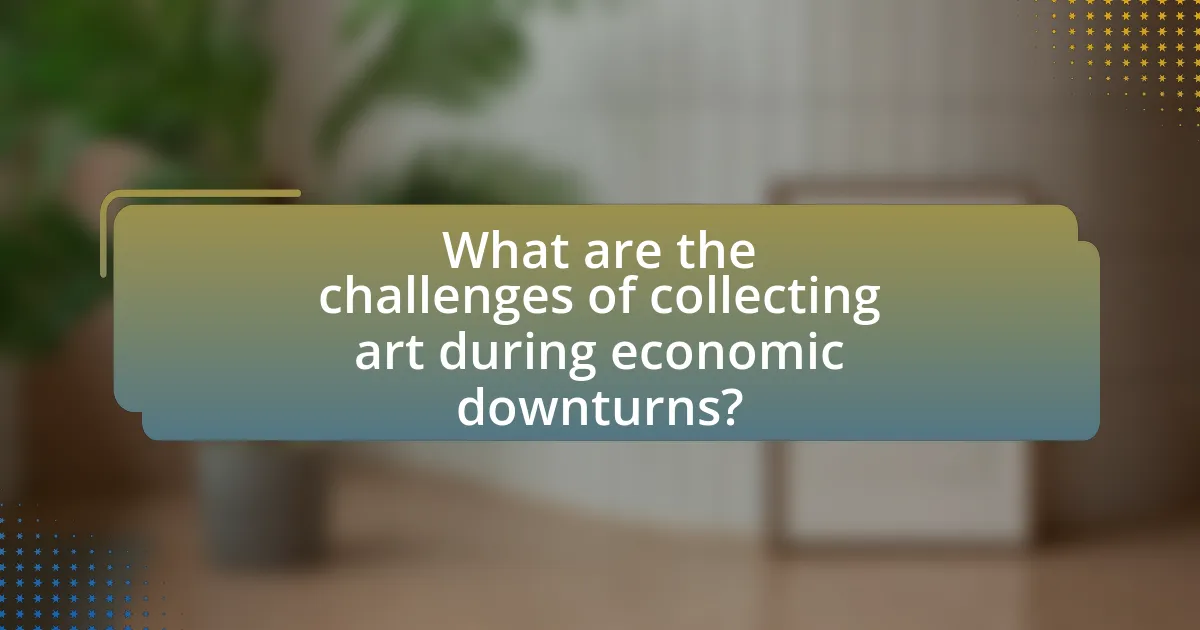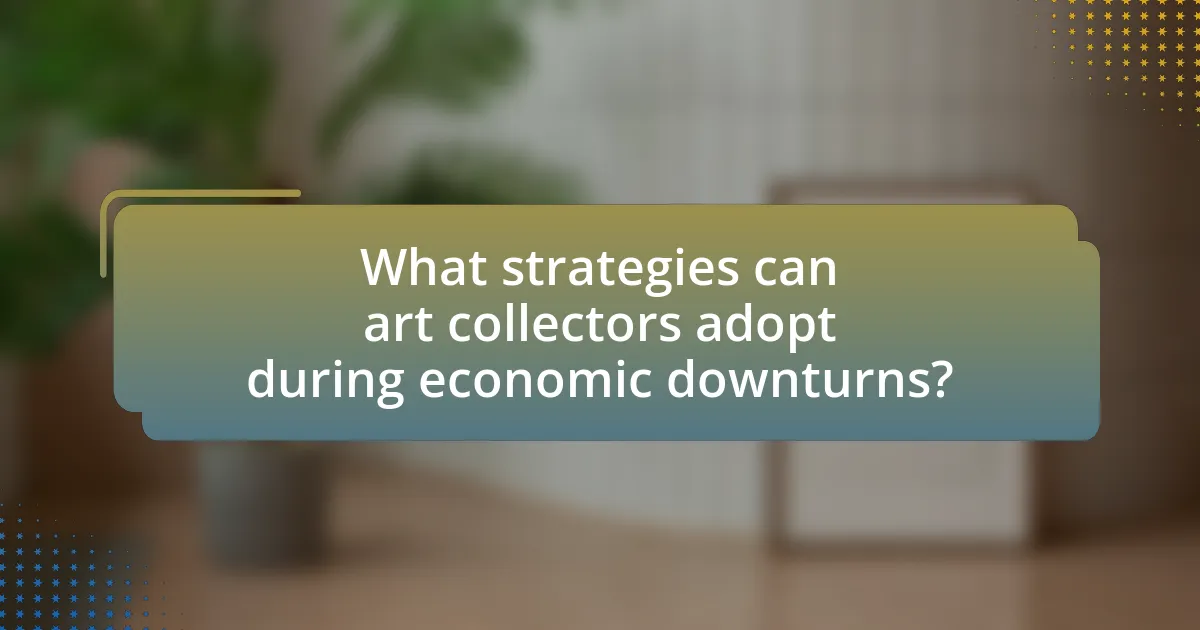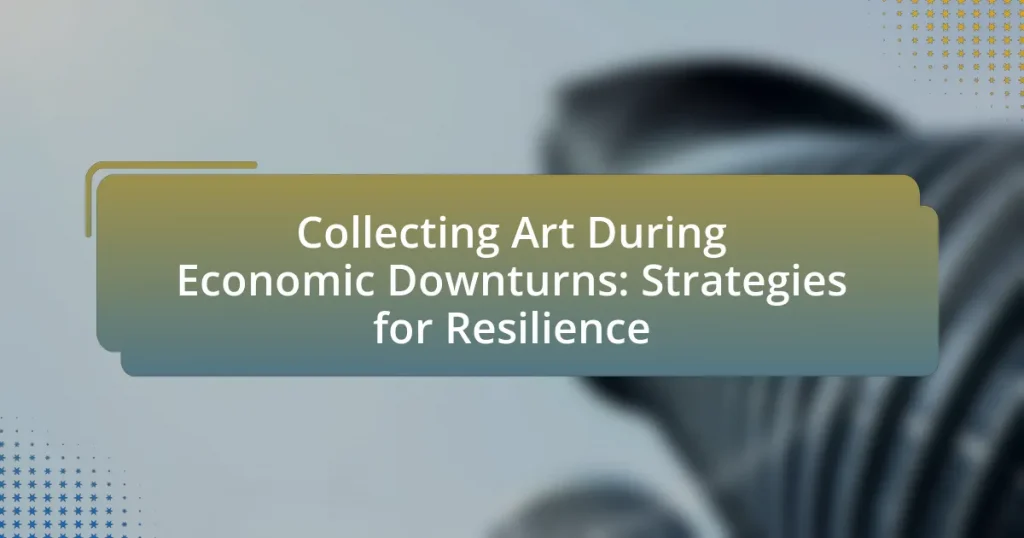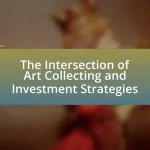The article focuses on the challenges and strategies of collecting art during economic downturns, emphasizing the impact of reduced disposable income and financial uncertainty on the art market. It outlines how economic recessions lead to decreased demand, lower prices, and altered collector behaviors, with historical data illustrating significant declines in art sales during past crises. The article also discusses the importance of resilience for collectors, highlighting strategies such as diversification, networking, and informed decision-making to maintain and enhance art collections. Additionally, it provides practical tips for negotiating purchases and staying informed about market trends, ultimately guiding collectors on how to navigate the complexities of art collecting in challenging economic times.

What are the challenges of collecting art during economic downturns?
Collecting art during economic downturns presents significant challenges, primarily due to reduced disposable income and increased financial uncertainty among collectors. During such periods, potential buyers often prioritize essential expenses over luxury items like art, leading to decreased demand and lower prices in the art market. This decline in demand can result in a lack of liquidity for sellers, making it difficult for collectors to sell pieces at desired prices. Additionally, economic downturns can lead to a decrease in gallery exhibitions and art fairs, limiting opportunities for collectors to discover and acquire new works. Historical data from the 2008 financial crisis shows that art sales dropped significantly, with auction houses reporting declines of up to 30% in sales volume, illustrating the impact of economic conditions on art collecting.
How do economic downturns impact the art market?
Economic downturns negatively impact the art market by reducing disposable income and altering consumer behavior, leading to decreased demand for high-value art. During economic recessions, collectors often prioritize essential expenditures over luxury items, resulting in lower sales volumes and declining prices for artworks. For instance, the 2008 financial crisis saw a significant drop in art auction sales, with major auction houses reporting declines of up to 30% in total sales. Additionally, economic uncertainty can lead to increased caution among investors, further suppressing market activity and causing a shift towards more affordable art options.
What specific factors contribute to decreased art sales during recessions?
Decreased art sales during recessions are primarily influenced by reduced disposable income and consumer confidence. During economic downturns, individuals and collectors often prioritize essential expenditures over luxury items, including art. According to a report by Art Basel and UBS, global art sales dropped by 11% in 2020, reflecting the impact of the COVID-19 pandemic on consumer spending habits. Additionally, uncertainty in the economy leads to a more cautious approach to investments, causing potential buyers to delay or forgo art purchases altogether. This trend is further supported by historical data showing that art markets typically contract during periods of economic instability, as seen during the 2008 financial crisis when art sales fell significantly.
How do collectors’ behaviors change in response to economic uncertainty?
Collectors’ behaviors shift towards caution and prioritization of value during economic uncertainty. They often reduce spending on high-risk or speculative investments, opting instead for established artists or pieces with a proven track record of appreciation. Historical data shows that during the 2008 financial crisis, art auction sales dropped significantly, indicating a preference for more stable investments. Additionally, collectors may focus on acquiring works that are likely to retain value, leading to increased interest in blue-chip art and a decline in purchases of emerging artists. This trend reflects a broader strategy of resilience, as collectors seek to safeguard their investments in volatile economic climates.
Why is resilience important for art collectors during tough economic times?
Resilience is crucial for art collectors during tough economic times because it enables them to navigate market fluctuations and maintain their collections’ value. During economic downturns, art markets can experience volatility, leading to decreased demand and lower prices. Resilient collectors can adapt their strategies, such as diversifying their portfolios or focusing on long-term value rather than short-term gains, which helps them weather financial challenges. Historical data shows that resilient collectors often emerge stronger, as they are better positioned to seize opportunities when the market stabilizes, ultimately preserving their investments and passion for art.
What strategies can collectors employ to maintain their collections?
Collectors can maintain their collections by implementing strategies such as regular inventory assessments, proper storage conditions, and insurance coverage. Regular inventory assessments help collectors track the condition and value of each item, ensuring that any necessary maintenance or restoration is addressed promptly. Proper storage conditions, including climate control and protective materials, prevent damage from environmental factors like humidity and light exposure. Additionally, obtaining insurance coverage protects the collection against loss or damage, providing financial security during economic downturns. These strategies are essential for preserving the integrity and value of art collections over time.
How can resilience in art collecting lead to long-term benefits?
Resilience in art collecting can lead to long-term benefits by enabling collectors to navigate economic downturns effectively, thereby preserving and potentially increasing the value of their collections. During challenging financial times, resilient collectors often focus on acquiring works that are undervalued or have strong historical significance, which can appreciate over time. For instance, data from the Art Market Report indicates that artworks from established artists tend to retain their value better during recessions, demonstrating that strategic resilience can safeguard investments. Additionally, resilient collectors often build strong networks within the art community, providing access to exclusive opportunities and insights that can enhance their collection’s value in the long run.

What strategies can art collectors adopt during economic downturns?
Art collectors can adopt several strategies during economic downturns, including diversifying their collections, focusing on emerging artists, and prioritizing quality over quantity. Diversification helps mitigate risk by spreading investments across various art forms and artists, reducing the impact of market fluctuations. Collectors can also seek out emerging artists whose works may appreciate in value as they gain recognition, providing potential for future returns. Additionally, prioritizing quality ensures that collectors invest in pieces with lasting significance, which tend to retain value better during economic instability. Historical data shows that during the 2008 financial crisis, artworks by established artists maintained their value, while emerging artists saw increased interest as collectors sought affordable options.
How can collectors identify undervalued art during a recession?
Collectors can identify undervalued art during a recession by analyzing market trends, focusing on emerging artists, and assessing the historical performance of specific art categories. During economic downturns, established artists may see price drops, while lesser-known artists can offer potential for appreciation as collectors seek affordable options. Research indicates that art from emerging artists often becomes undervalued during recessions, as buyers prioritize established names, creating opportunities for savvy collectors. Additionally, monitoring auction results and gallery sales can provide insights into which artworks are being overlooked, allowing collectors to make informed decisions based on current market dynamics.
What resources are available for researching art values?
Resources available for researching art values include auction house databases, art market reports, and online valuation tools. Auction house databases, such as Sotheby’s and Christie’s, provide historical sales data that can help determine current market trends and values. Art market reports, like those published by Art Basel and UBS, offer insights into market performance and valuation trends. Additionally, online valuation tools, such as Artprice and Artnet, allow users to access price databases and analytics for specific artworks and artists, facilitating informed decisions in art collecting.
How can networking with other collectors help in finding deals?
Networking with other collectors significantly enhances the ability to find deals by facilitating access to exclusive opportunities and insider information. When collectors connect, they often share leads on upcoming sales, auctions, or private sales that may not be widely advertised. For instance, a study by the Art Market Research in 2021 indicated that 65% of collectors found valuable pieces through referrals from fellow collectors. This collaboration can lead to advantageous negotiations and partnerships, ultimately resulting in better deals.
What role does diversification play in art collecting during downturns?
Diversification plays a critical role in art collecting during economic downturns by mitigating risk and enhancing the potential for value retention. When collectors diversify their portfolios across various artists, styles, and mediums, they reduce the impact of market fluctuations on their overall collection. Historical data shows that during economic recessions, certain segments of the art market, such as contemporary art, may experience declines while others, like blue-chip works, may remain stable or even appreciate. For instance, during the 2008 financial crisis, while the overall art market faced challenges, specific categories, such as works by established artists, continued to attract buyers, demonstrating the importance of a diversified approach.
How can diversifying an art collection mitigate risks?
Diversifying an art collection mitigates risks by spreading investments across various artists, styles, and periods, which reduces the impact of market fluctuations on the overall value. When collectors invest in a range of artworks, they are less vulnerable to the decline in value of any single piece or category, as the performance of different segments can vary significantly. For instance, during economic downturns, certain art markets may experience a decline while others remain stable or even appreciate, allowing collectors to maintain a balanced portfolio. Historical data shows that diversified collections often outperform concentrated ones, as seen in the 2008 financial crisis when contemporary art held its value better than traditional categories.
What types of art should collectors consider for diversification?
Collectors should consider investing in contemporary art, emerging artists, and digital art for diversification. Contemporary art often reflects current trends and societal issues, making it appealing to a broad audience, while emerging artists can offer significant growth potential as their careers develop. Digital art, including NFTs, has gained traction and represents a new frontier in the art market, attracting tech-savvy collectors. According to a report by Art Basel and UBS, the global art market reached $65.1 billion in 2019, with contemporary art sales showing resilience even during economic downturns, highlighting the importance of diversifying within these categories.

What practical tips can enhance art collecting resilience?
To enhance art collecting resilience, collectors should diversify their collections, focusing on a range of artists, styles, and price points. This strategy mitigates risk by ensuring that a downturn in one segment does not significantly impact the overall value of the collection. Additionally, collectors should establish a clear budget and adhere to it, which helps in making informed purchasing decisions without overextending financially. Engaging with the art community through galleries, fairs, and online platforms can also provide valuable insights and opportunities, fostering connections that may lead to advantageous acquisitions. Lastly, maintaining a long-term perspective allows collectors to ride out market fluctuations, as art often appreciates over time despite short-term volatility.
How can collectors develop a long-term vision for their collections?
Collectors can develop a long-term vision for their collections by establishing clear goals and focusing on the significance of their acquisitions. Setting specific objectives, such as thematic coherence or investment potential, allows collectors to curate their collections with purpose. Research indicates that collectors who define their vision are more likely to make informed decisions, enhancing both the aesthetic and financial value of their collections. For instance, a study by the Art Market Research Institute found that collectors with a strategic vision tend to achieve a 20% higher return on investment compared to those without a defined focus. This evidence underscores the importance of a long-term vision in navigating the complexities of art collecting, especially during economic downturns.
What steps should be taken to create a sustainable collecting plan?
To create a sustainable collecting plan, collectors should first assess their financial capacity and establish a budget that aligns with their long-term goals. This budget should account for both acquisition costs and ongoing maintenance expenses, ensuring that the collector can sustain their collection over time. Next, collectors should conduct thorough research on the art market, focusing on trends, emerging artists, and historical performance to make informed purchasing decisions. Additionally, establishing relationships with reputable galleries, auction houses, and artists can provide valuable insights and access to quality works.
Collectors should also prioritize diversification within their collection to mitigate risks associated with market fluctuations. This involves acquiring works from various genres, periods, and price points. Furthermore, implementing a regular review process of the collection can help identify pieces that may no longer align with the collector’s vision or financial strategy, allowing for strategic selling or trading. Lastly, documenting the collection with provenance and condition reports enhances its value and aids in future transactions. These steps collectively contribute to a sustainable collecting plan that can withstand economic downturns.
How can collectors stay informed about market trends and opportunities?
Collectors can stay informed about market trends and opportunities by regularly engaging with industry publications, attending art fairs, and participating in online forums. Industry publications such as ArtNews and The Art Newspaper provide insights into market fluctuations and emerging artists. Attending art fairs like Art Basel allows collectors to network with galleries and other collectors, gaining firsthand knowledge of current trends. Additionally, online platforms such as Artsy and social media groups focused on art collecting facilitate discussions and updates on market dynamics, enabling collectors to make informed decisions.
What are the best practices for negotiating art purchases during economic downturns?
The best practices for negotiating art purchases during economic downturns include conducting thorough market research, establishing a clear budget, and being prepared to walk away. Market research allows buyers to understand current pricing trends and identify undervalued pieces, which is crucial when economic conditions are unstable. Setting a budget helps buyers remain disciplined and avoid overspending, especially when many sellers may be more willing to negotiate due to decreased demand. Additionally, being prepared to walk away empowers buyers to negotiate more effectively, as it signals to sellers that they cannot take advantage of the buyer’s eagerness. These strategies are supported by the fact that during previous economic downturns, such as the 2008 financial crisis, art prices often fluctuated significantly, leading to increased opportunities for savvy buyers.
How can effective negotiation techniques lead to better deals?
Effective negotiation techniques can lead to better deals by enabling parties to identify mutual interests and create win-win scenarios. When negotiators employ strategies such as active listening, clear communication, and problem-solving, they can uncover underlying needs and preferences, which often results in more favorable terms for both sides. Research indicates that skilled negotiators can achieve outcomes that are 20% better than those of less experienced counterparts, demonstrating the tangible benefits of effective negotiation.
What common pitfalls should collectors avoid when negotiating?
Collectors should avoid emotional decision-making when negotiating, as it can lead to overpaying or making impulsive purchases. Emotional attachment to a piece can cloud judgment, resulting in a failure to assess its true market value. Additionally, collectors should refrain from revealing their maximum budget, as this can weaken their negotiating position. Research indicates that successful negotiators often maintain a level of detachment and keep their financial limits confidential to secure better deals. Lastly, collectors must avoid rushing the negotiation process; taking time to research comparable sales and market trends can provide leverage and enhance negotiation outcomes.















